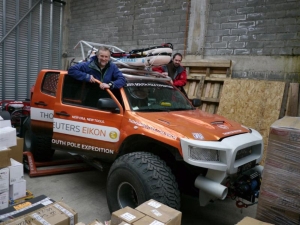South Pole speed recordMany people want to go to the end of the Earth. In many ways. Yesterday we saw the custom-made Toyota that will set a speed record in January. Traversing the distance between Union Glacier and the South Pole (around 1000 kilometres) in 24 hours is a possibility.

With gargantuan wheels and partially filled tyres, the specially built Toyota will press on over snow, ice, and crevasses at 50 km/hour. We can only imagine how bruised and battered the drivers will be when they alight at the Pole. Huge fuel tanks have been mounted at the rear of the vehicle, but it will also tow a sled full of all the field gear required. Even an expedition of this kind must be prepared for inclement weather and involuntary stops. Antarctic tourism is developing at a tremendous pace. The largest category of tourists is those who visit the Antarctic Peninsula aboard cruise liners. A few years ago the number climbed to over 40,000 but visits have stabilised in the wake of the financial crisis. This steady stream of tourists highlights several challenges, such as unreliable nautical maps, inadequate search and rescue services, extremely limited possibilities of handling oil spills, and potential threats to penguin colonies and cultural heritage sites. Land-based tourism is still on a relatively modest scale, but this type of tourism is extremely demanding in terms of logistics and safety. This year nearly 200 mountaineers intend to climb Mount Vinson (elevation 4897 m) the highest peak in Antarctica. About the same number of people intend to go to the South Pole – by skis, by plane, or by custom-made car. What will the traffic situation be 20 years from now? Did you know that the term Antarctic actually comes from “anti-Arctic”?
The name Arctic comes from the Greek word Arktos, which means bear. The bears in question are not polar, but celestial: the Great and the Little Bear, constellations visible only in the Northern Hemisphere. Antarktikos – Antarctica – is thus the opposite of “the land of the bear” and is situated on the other side of the planet. |
South Pole 1911–2011 is an informational outreach project run by the Norwegian Polar Institute
Contact person:


